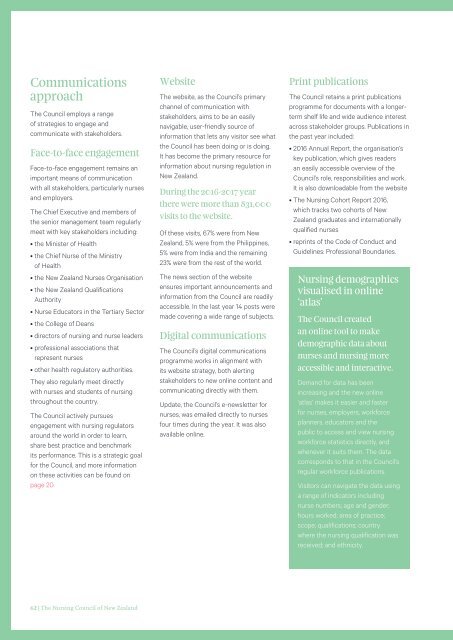NZNA_AnnualReport2017_280817_v10_small
Create successful ePaper yourself
Turn your PDF publications into a flip-book with our unique Google optimized e-Paper software.
Communications<br />
approach<br />
The Council employs a range<br />
of strategies to engage and<br />
communicate with stakeholders.<br />
Face-to-face engagement<br />
Face-to-face engagement remains an<br />
important means of communication<br />
with all stakeholders, particularly nurses<br />
and employers.<br />
The Chief Executive and members of<br />
the senior management team regularly<br />
meet with key stakeholders including:<br />
• the Minister of Health<br />
• the Chief Nurse of the Ministry<br />
of Health<br />
• the New Zealand Nurses Organisation<br />
• the New Zealand Qualifications<br />
Authority<br />
• Nurse Educators in the Tertiary Sector<br />
• the College of Deans<br />
• directors of nursing and nurse leaders<br />
• professional associations that<br />
represent nurses<br />
• other health regulatory authorities.<br />
They also regularly meet directly<br />
with nurses and students of nursing<br />
throughout the country.<br />
The Council actively pursues<br />
engagement with nursing regulators<br />
around the world in order to learn,<br />
share best practice and benchmark<br />
its performance. This is a strategic goal<br />
for the Council, and more information<br />
on these activities can be found on<br />
page 20.<br />
Website<br />
The website, as the Council’s primary<br />
channel of communication with<br />
stakeholders, aims to be an easily<br />
navigable, user-friendly source of<br />
information that lets any visitor see what<br />
the Council has been doing or is doing.<br />
It has become the primary resource for<br />
information about nursing regulation in<br />
New Zealand.<br />
During the 2016-2017 year<br />
there were more than 831,000<br />
visits to the website.<br />
Of these visits, 67% were from New<br />
Zealand, 5% were from the Philippines,<br />
5% were from India and the remaining<br />
23% were from the rest of the world.<br />
The news section of the website<br />
ensures important announcements and<br />
information from the Council are readily<br />
accessible. In the last year 14 posts were<br />
made covering a wide range of subjects.<br />
Digital communications<br />
The Council’s digital communications<br />
programme works in alignment with<br />
its website strategy, both alerting<br />
stakeholders to new online content and<br />
communicating directly with them.<br />
Update, the Council’s e-newsletter for<br />
nurses, was emailed directly to nurses<br />
four times during the year. It was also<br />
available online.<br />
Print publications<br />
The Council retains a print publications<br />
programme for documents with a longerterm<br />
shelf life and wide audience interest<br />
across stakeholder groups. Publications in<br />
the past year included:<br />
• 2016 Annual Report, the organisation’s<br />
key publication, which gives readers<br />
an easily accessible overview of the<br />
Council’s role, responsibilities and work.<br />
It is also downloadable from the website<br />
• The Nursing Cohort Report 2016,<br />
which tracks two cohorts of New<br />
Zealand graduates and internationally<br />
qualified nurses<br />
• reprints of the Code of Conduct and<br />
Guidelines: Professional Boundaries.<br />
Nursing demographics<br />
visualised in online<br />
‘atlas’<br />
The Council created<br />
an online tool to make<br />
demographic data about<br />
nurses and nursing more<br />
accessible and interactive.<br />
Demand for data has been<br />
increasing and the new online<br />
‘atlas’ makes it easier and faster<br />
for nurses, employers, workforce<br />
planners, educators and the<br />
public to access and view nursing<br />
workforce statistics directly, and<br />
whenever it suits them. The data<br />
corresponds to that in the Council’s<br />
regular workforce publications.<br />
Visitors can navigate the data using<br />
a range of indicators including<br />
nurse numbers; age and gender;<br />
hours worked; area of practice;<br />
scope; qualifications; country<br />
where the nursing qualification was<br />
received; and ethnicity.<br />
62 | The Nursing Council of New Zealand


